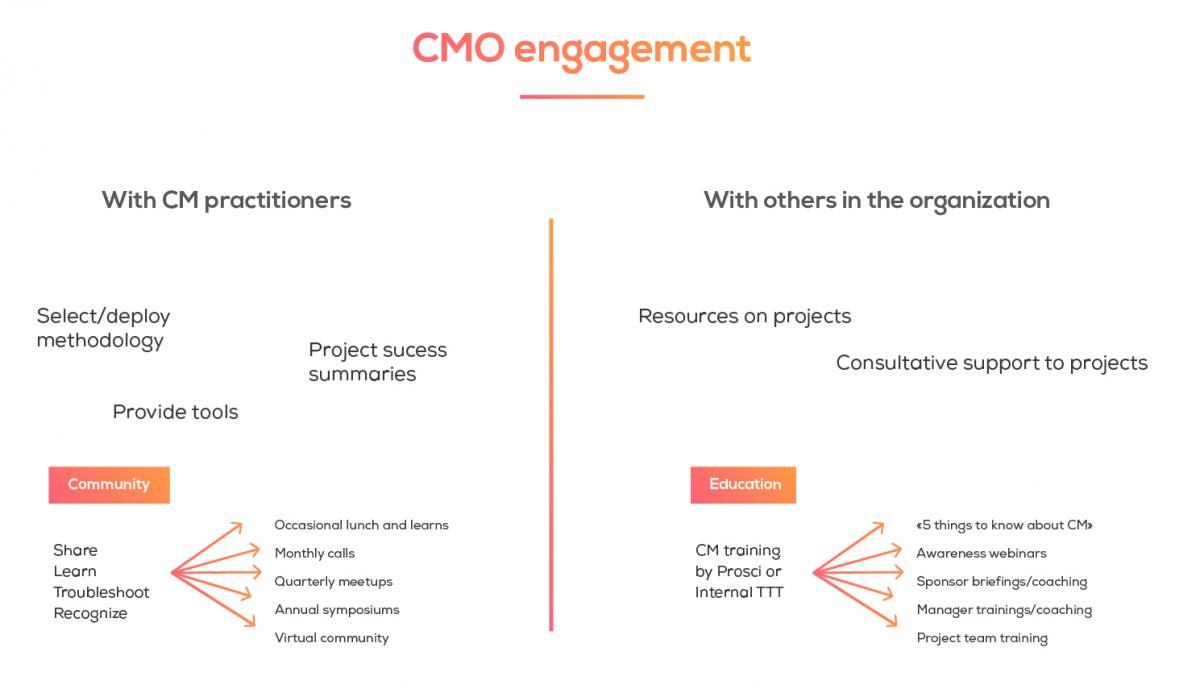What is a CMO and why you should consider setting one up. (I)
12 Jul 2021
Article written by Vincent PIEDBOEUF
12 Jul 2021
Article written by Vincent PIEDBOEUF
Change Management Offices, or CMO, are mushrooming. That said, it is not unusual to come across many variations in formulation. Whatever their name – CM Network, CM Division, CM Team or Enterprise CM …, the list goes on –, all refer to the existence of an overarching functional structure that orchestrates CM efforts across the workplace. Yet, there is no one-size fits-all format.
Have you ever wondered what extra benefits a CMO can bring to your organisation and how to set up one that will meet your needs? Whether you are currently applying CM to projects or just consider the best way to climb the CM maturity ladder, this series of 3 articles is for you. In this first post, we go back to the basics and explore the reasons why CMOs are more popular than ever before … and their very raison d’être.
CMOs: elevated Change Management.
Before going even further, let’s give a bit of context. According to a worldwide survey conducted by PROSCI, CMOs are currently found in 40% of all participating entities. The retail trade, the banking sector and governments are one step ahead of the curve. CMOs also seem to be a staple for biggest organisations employing between 10.000 up to 35.000 people. The higher the maturity in terms of Change Management, the most likely there will be a dedicated functional group. It is only logical given that CMOs are the ultimate feature of a mature organisation that may have started its journey by applying CM on isolated or multiple projects (stage 2 & 3), then proceeded to establish common organisational standards or norms (stage 4) and finally turned CM into a full-on competency (stage 5) [insert URL previous article on maturity].
Not for nothing is the development of CMOs seen a major trend for the 5 years to come: the success rate of projects is highly correlated to the degree of CM maturity. On average, “Stage 5” organisations boast of a 66% success rate, compared to 16% for those where CM is absent or a modest 31% where it is only applied sporadically. Overall, having a structured framework contributes to agility and alleviates saturation while reducing its associated costs. It also helps implement strategies, creates a competitive advantage and last but least, multiplies the benefits delivered by CM. When it comes to taking CM to the next level, that of an organisational aptitude, CMOs are a vital part of the process!
There is no better way to formalise these upgrades than to create a dedicated box on the organisational chart. If you feel that this is a mere cosmetic move, think again. Setting the new reality on paper somehow authorises and legitimises it. Also, it is a powerful instrument for stabilisation and socialisation.
CMO: what’s in a name.
Now, it is crucial to understand what a CMO’s mission is and what its members are expected to do. Most respondents to the above-mentioned PROSCI’s survey stated that the CMO’s very first task is to guarantee a thorough understanding and consistent application of CM methodology under all conditions. Likewise, it is in charge of maintaining CM tools and providing advisory support and resources to Project team members. Another important area of action is the development of a lively CM community where knowledge can be circulated and feedback collected. While paving the way for the CM implementation, CMOs also offer backup coaching to sponsors. As functional and centralised units, CM Offices are best placed to track progress, train the middle management to cascade the change and, on a more general note, manage the portfolio of changes.
These main focus areas ranked by order of (perceived) importance are further summarised in the graph below. The permanent character of CMOs and the coordinating function they perform are crucial to increase change readiness. But making them truly effective requires active sponsorship, measurable goals, clearly specified roles and relationships (ecosystem where project teams, sponsors, managers and CMO are constantly interacting). Above all, the decision to create a dedicated CM group or Office should be treated as a change process in itself ….

If developing a real organisational aptitude to manage and drive future changes is at the top of your agenda, you may now want to get down to the nuts and bolts of how to set up a CMO. Because CMOs come in many shapes and sizes, we have other articles coming up that cover everything from the best possible format to the most suitable articulation with other business functions. Stay tuned and be ready to move to practical action!
Auditing CM Maturity: 5 Capability Areas
Here are the five capability areas that must be factored in to determine the “maturity” of your organisation.
Written by
Vincent PIEDBOEUF
Change Management: how mature is your organization?
Improve how your organization operates and performs during times of change. Use Prosci’s Change Management maturity model as a guide to move up the maturity ladder.
Written by
Caroline Morck Jensen